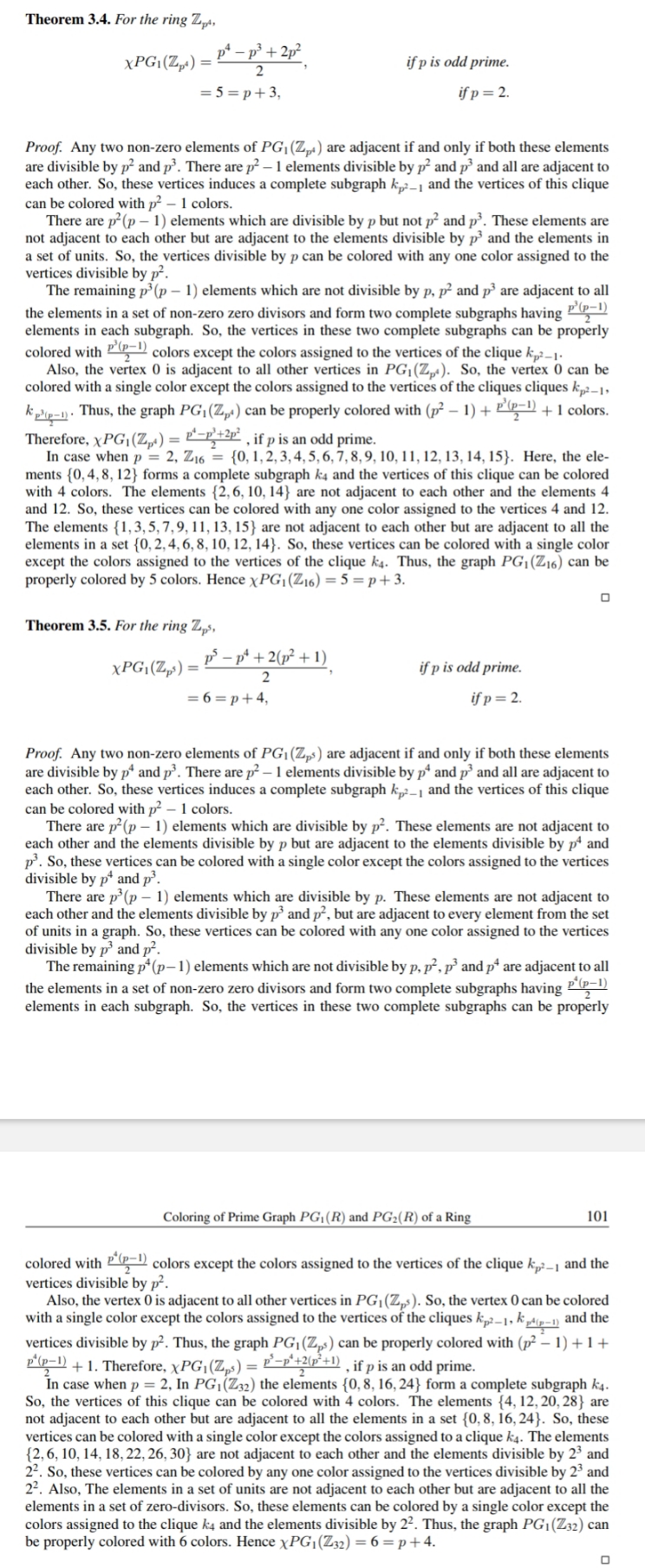make an example for theorems 3.4 and 3.5 with p = 2
Theorem 3.4. For the ring ., 4 .3 XPGi(Zy) = % ifp is odd prime. =5=p+]3, ifp=2. Proof. Any two non-zero elements of PG (Z,) are adjacent if and only if both these elements are divisible by p\" and p*. There are p* | elements divisible by \" and p* and all are adjacent to each other. So, these vertices induces a complete subgraph k., and the vertices of this clique can be colored with p* 1 colors. There are p*(p 1) elements which are divisible by p but not p* and p*. These elements are not adjacent to each other but are adjacent to the elements divisible by p* and the elements in a set of units. So, the vertices divisible by p can be colored with any one color assigned to the vertices divisible by p. The remaining p*(p 1) elements which are not divisible by p, p*> and p* are adjacent to all the elements in a set of non-zero zero divisors and form two complete subgraphs having 'i']] elements in each subgraph. So, the vertices in these two complete subgraphs can be properly colored with M colors except the colors assigned to the vertices of the clique k. ;. Also, the vertex 0 is adjacent to all other vertices in PG (Z,:). So, the vertex 0 can be colored with a single color except the colors assigned to the vertices of the cliques cliques k., kw. Thus, the graph PG (Z,4) can be properly colored with (p* 1) + \"'%'\" + | colors. Therefore, xPG(Z) = &f-';zp ,if p is an odd prime. In case when p = 2, Zjs = {0,1,2,3,4,5,6,7,8,9,10,11,12,13,14,15}. Here, the ele- ments {0, 4,8, 12} forms a complete subgraph ks and the vertices of this clique can be colored with 4 colors. The elements {2, 6, 10, 14} are not adjacent to each other and the elements 4 and 12. So, these vertices can be colored with any one color assigned to the vertices 4 and 12. The elements {1,3,5,7,9,11, 13, 15} are not adjacent to each other but are adjacent to all the elements in a set {0,2.4,6,8, 10,12, 14}. So, these vertices can be colored with a single color except the colors assigned to the vertices of the clique k4. Thus, the graph PGy(Z)s) can be properly colored by 5 colors. Hence y PGy (Zyg) =5 = p+ 3. o Theorem 3.5. For the ring s, P p*+ 2P +1 XPG\\(Z,5) = '#2(""') =6=p+4, ifp=2. if p is odd prime. Proof. Any two non-zero elements of PG\\ (Z,s) are adjacent if and only if both these elements are divisible by p* and p*. There are p\" 1 elements divisible by p* and p* and all are adjacent to each other. So, these vertices induces a complete subgraph k., and the vertices of this clique can be colored with p* 1 colors. There are p'(p 1) elements which are divisible by p. These elements are not adjacent to each other and the elements divisible by p but are adjacent to the elements divisible by p* and p. So, these vertices can be colored with a single color except the colors assigned to the vertices divisible by p* and p. There are p*(p 1) elements which are divisible by p. These elements are not adjacent to each other and the elements divisible by p* and p, but are adjacent to every element from the set of units in a graph. So, these vertices can be colored with any one color assigned to the vertices divisible by p* and p*. The remaining p*(p 1) elements which are not divisible by p, p*. p* and p* are adjacent to all the elements in a set of non-zero zero divisors and form two complete subgraphs having @ elements in each subgraph. So, the vertices in these two complete subgraphs can be properly Coloring of Prime Graph PG, (R) and PG,( R) of a Ring 101 colored with "z"'} colors except the colors assigned to the vertices of the clique k., and the vertices divisible by p. Also, the vertex 0 is adjacent to all other vertices in PG (Z; ). So, the vertex 0 can be colored with a single color except the colors assigned to the vertices of the cliques k: |, k o and the vertices divisible by p. Thus, the graph PG\\ (Z,;:) can be properly colored with (p> 1) + 1+ ';ii + 1. Therefore, x PG (Zs) = w . if p is an odd prime. In case when p = 2, In PG (Z3;) the elements {0, 8, 16,24} form a complete subgraph k. So, the vertices of this clique can be colored with 4 colors. The elements {4, 12,20, 28} are not adjacent to each other but are adjacent to all the elements in a set {0.8, 16,24}. So, these vertices can be colored with a single color except the colors assigned to a clique k4. The elements {2.6, 10, 14,18, 22, 26, 30} are not adjacent to each other and the elements divisible by 2% and 22, So, these vertices can be colored by any one color assigned to the vertices divisible by 2* and 22, Also, The elements in a set of units are not adjacent to each other but are adjacent to all the elements in a set of zero-divisors. So, these elements can be colored by a single color except the colors assigned to the clique ks and the elements divisible by 2. Thus, the graph P(1(Z3;) can be properly colored with 6 colors. Hence yPG(Z3) =6 =p+ 4. o







